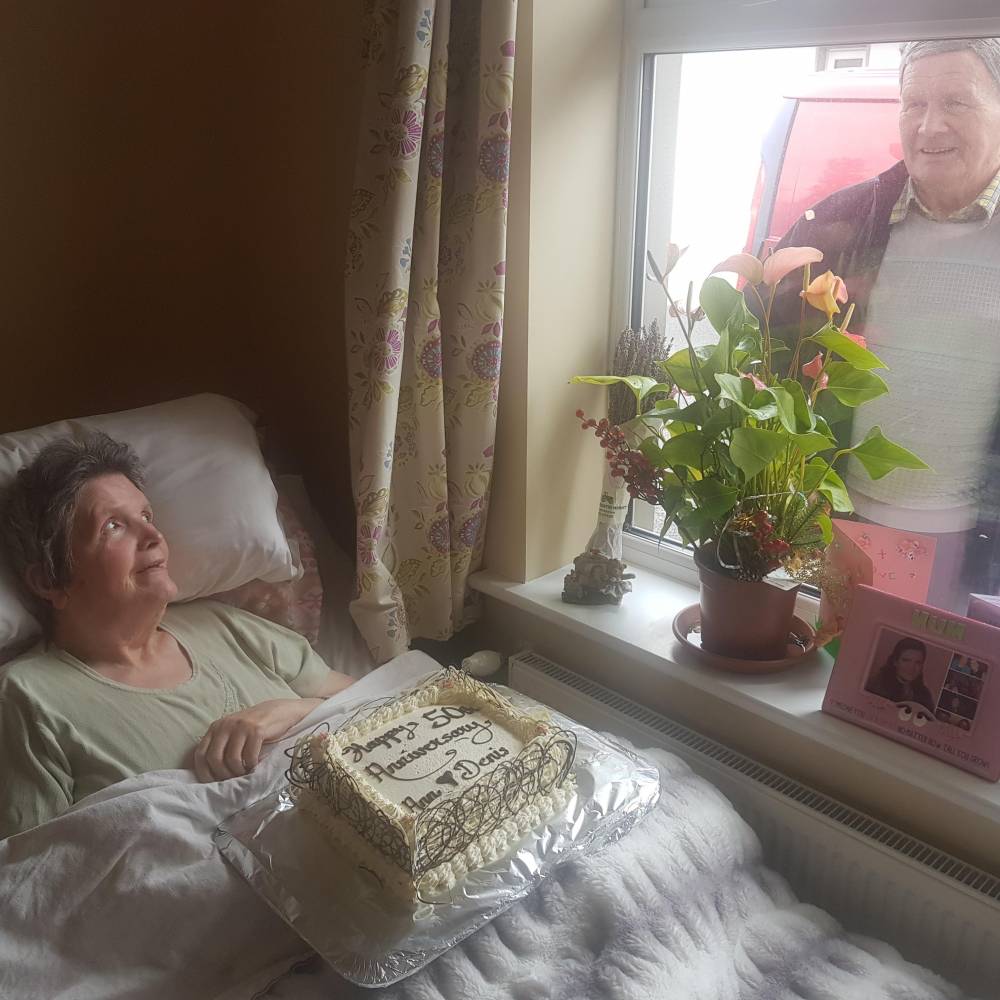
Food is much more than something we consume to give us sustenance.
Families gather over food and talk about their day.
We feast on special occasions like Christmas and Easter, and we eat special foods to celebrate, such as on birthdays and anniversaries.
But for those living with dysphagia, a condition common among older people living with dementia that makes it difficult to eat and drink, there are barriers to engaging in these special occasions, not only due to problems with communication but also because of restrictions on joining in the ritual of eating.
Sometimes people with dysphagia may be excluded from these gatherings altogether.
For Niamh Condon of Dining with Dignity, helping create visually appealing food that tastes great for those who require texture modified diets has become a passion.

During lockdown near Ms Condon’s home in County Cork, Ireland, a woman asked her to help sourcing a cake to celebrate her parents’ 50th wedding anniversary.
The woman’s mother was living in residential aged care and was on an IDDSI (International Dysphagia Diet Standardisation Initiative) Level 5 diet. Cake is usually ruled out for Level 5 diets, but Ms Condon did what she always does. She set about finding a way to create a texture modified food that looked and tasted like the original item.
The anniversary arrived, and the elderly woman’s husband and their son went to visit through the window of the home – the husband, who is living with dementia, finding it difficult to understand why he couldn’t be beside his wife of half a century.
Ms Condon arrived with the cake, which immediately made the occasion more festive. Ms Condon managed to open a window a sliver so the couple could speak, and the husband sang ‘Brown Eyed Girl’ to his beaming wife.
Ms Condon snapped only a single photo that day, but it captures the special moment perfectly.
“It was so sad,” Ms Condon said when she spoke to HelloCare. “It was just a cake, but every occasion revolves around food. If you exclude people from the food, you exclude them from what they’re celebrating, from the activity, and from the social environment.
“As best we can, we need to look at how we can offer that food. As chefs, we need to think outside the box and think about how we can make this work.

Ms Condon began cooking at the age of 12 when she was working for her uncle in his delicatessen. She studied food process engineering when she left school, but found the course was too far removed from the ingredients and the human aspects of food, which she loved.
It was only when she began working in a nursing home in West Cork and was asked to serve three scoops of food on a plate, that she found her calling.
“It was fresh food, cooked well, but I found it challenging because of the way I was presenting the food. I couldn’t get my head around it,” Ms Condon said.
“I wouldn’t eat it because I didn’t recognise it, so why would I expect anyone else to eat it,” she said.
Ms Condon knows from experience what eating texture modified food is like. She consumed an IDDSI Level 4 diet for both food and drink for three days with the support of a dietitian as an experiment.
“This challenged me to see the struggles that people face with eating,” she said.
She missed small things, like having freshly ground pepper on her meals, and didn’t like the sensation of the savoury foods she was allowed. Drinks were so thick, she had to use a spoon to consume them.
“There are people with dysphagia who are not in aged care,” she said. “The social aspect of them enjoying a meal with others would be a huge challenge.”
Recognisable food more palatable
If you serve food that looks and smells the way it is supposed to so that people recognise it, then meals are much more likely to be eaten, Ms Condon believes.
She uses moulds (from Australian company the Pure Food Mould Company) and piping to create varied textures. She layers flavours and colours to make the food as palatable as possible, both visually and in terms of taste and texture.
Food is always pureed at the temperature it will be served at to preserve colour and texture.
Ms Condon usually has food ready to be served half an hour before it’s due to be eaten, and she uses that time to do the pureeing.
With no training available in Cork to create this type of texture modified food, Ms Condon began consulting to homes at the beginning of 2020. COVID-19 has slowed her plans, but she is still passionate about what she does.
The pandemic is having an impact on residents, too. Their psychological wellbeing is being affected, and it’s having an impact on their eating, Ms Condon said. The risk of infection control must be weighed against the risk to people’s health and wellbeing, she believes.
“If they’re in lockdown within four walls, it’s very difficult for them not seeing their family. They refuse food. I find it harder to get them to eat. They’ve given up.
“It’s heartbreaking,” she said.
But Ms Condon is highly experienced, and she distracts the residents enough to eventually get them to eat. “I say ‘what’s this’ and ‘who’s what’, ‘come on, let’s have a cup of tea’, and then maybe they’ll sit down and eat,” she said.
“When this virus hit, everybody panicked and the social aspect of the food was taken away completely from them.” Residents were often sitting down to a plate of food on their own. With the social aspect removed, many wouldn’t eat.
“It was their way of fighting back,” Ms Condon said.

Ms Condon is consulting to nursing homes, helping restructure kitchen operations, and helping produce food for all levels of IDDSI.
She trains staff in care homes too, and always begins by involving everyone on staff – from the cleaners to the managers, the dieticians to the speech and language therapists.
“They all need to understand that any feedback that’s given is so important. If a cleaner is walking past somebody’s room and they haven’t eaten their meal, if that isn’t relayed back to the kitchen, then there’s an issue. Why didn’t they eat their meal? Didn’t they like it, or are they just not hungry? Or were they having a bad day?”
Ms Condon continued, “I’ve been shouting from the rooftops to get a connection between the kitchen and the dieticians and the speech and language therapists. They all have to work together.”
However, the most important link in the chain are the care staff who are assisting the residents.
“You need to find out what’s happening with that plate. Everyone feels included if they can tell you what’s happening. If they tell me some food didn’t work out, I don’t get insulted, I just change what I am doing. At the end of the day, once the resident is happy, everybody is happy.”
Residents at the home where she is working at the moment can eat at any time of day. And that’s the way it should be, she said. “At the end of the day, we’re working in somebody’s home. It’s not the other way around.”

I reached out to Ms Condon for this article after seeing a photo of lamb shanks she’d prepared posted on LinkedIn.
“If I cook any meal now, I think, ‘Can I make that into an IDDSI meal?’ It was a case of, ‘Why not?’ Just take the meat off the bone and remould it.”
Ms Condon continued, “We’ve done fish and chips. We’ve done steak and chips. We’ve done birthday cakes, a scone with jam and cream. Sandwiches are a bit more difficult because of the setting of the bread. The idea of a sandwich is you pick it up.” But she found a way to do it using a gelling agent containing agar-agar and pectin created by an Australian company called Flavour Creations.
She knows her work is successful because she sees the looks on the residents’ faces when they see and eat the food.
“Their faces tell a lot,” she said. “They recognise it, and they smile. They can smell the food, but the smell and the visual appearance they recognise together, and that’s important. They’re not smelling carrots and it looks like something completely different.
“Their plates are usually empty coming back, which is always a good sign.”
Ms Condon shared, “I set out to try and help as many chefs, or people who are cooking for people with dysphagia, as I could, whether that was through training, or social media, or possibly webinars going forward.
“And I wanted to help those who were sitting around the table facing three scoops on a plate.”
Sadly most residents living with advanced dementia don’t just have trouble swallowing, they actually forget how to eat and don’t recognise food at all.
It’s not hard to imagine when you know that they commonly forget the name of the spouse or children and that would be the most important thing to them.
Lots of these folk that make these recommendations need to clarify who and what extent of affect the disease has had because some people will automatically think that its all about presentation.
This is a great initiative but I fail to see it ever occurring as Aged Care in general is so time poor due to funding shortfalls to implement a change to diets as this. I work in the sector and so far after the Royal Commission findings and then recommendations I am not hopeful that much will change to improve the lives of residents and working conditions of those who care for them.
Wow Ms. Condon thank you! Inspiring to hear what you have done.
Wonderful and inspiring! I agree it takes a team to provide great care!
Thank you for all your hard work, helping to pave the way for all to use the IDDSI framework for successful texture modified foods/drinks. All your extra efforts with presentation is appreciated. If we can all adopt one or two of the ideas I learned from reading this, all people with dysphagia will have an improved dining experience. I enjoy that you try to make safe IDDSI approved food from as many food items as possible.
Thank you!
My mother has late stage cancer and I’m home hospice.. she can only have liquids and puréed food. I want to spoil her as much as I can and want to learn how to make everything!!